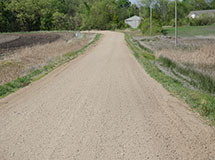 |
 |
|
| eNews • December 2013 | ||
| Promoting a Cost-Effective, Reliable and Competitive Transportation System |
||
 STC Rural Infrastructure Study Calls for “A More Productive Path Forwardâ€
STC Rural Infrastructure Study Calls for “A More Productive Path Forwardâ€
In rural America we are observing a growing friction between an increasingly abundant and productive agricultural sector on one hand, and a rural infrastructure that is ill-equipped to accommodate it. While yields are projected to increase substantially in the future, the funding to maintain rural roads and bridges is stagnant or on the decline.
“As economies and industries progress, so must transportation systems progress,” says Pat Knouff, a soybean farmer from Minster, Ohio, and chairman of the Soy Transportation Coalition. “If the infrastructure fails to do so, costs and inefficiencies will escalate and our competitiveness will diminish. This has unfortunately happened in rural America.”
“U.S. agriculture can accurately be described as a 21st century industry utilizing an early 20th century rural infrastructure,” explains Mike Steenhoek, executive director of the Soy Transportation Coalition. “Modern agriculture requires a modern delivery system. Our rural infrastructure, however, was designed and constructed with assumptions and realities that are no longer applicable.”
The Soy Transportation Coalition recently released a research project, “Rural Infrastructure: A More Productive Path Forward,” that examines the condition and shortcomings of our nation’s rural infrastructure and potential proposals to address them.
The analysis, performed by Informa Economics, focused on four questions: 1.) How is the current rural infrastructure incompatible with modern agriculture?, 2.) How costly would it be to upgrade the current system to meet the needs of modern agriculture?, 3.) How much funding will likely be available to finance these infrastructure enhancements?, and 4.) If cost prohibitive, what kind of solutions does agriculture need to explore – what kind of “outside of the box” thinking needs to occur?
The analysis profiles eleven leading soybean producing states and how agriculture has advanced while the rural infrastructure has remained stagnant. “Over the past 60 years, our research highlights in each state how the number of farms has gone down, the percentage of people living in rural areas has gone down, and the percentage of production consumed on the farm has gone down,” says Scott Gauslow, a soybean farmer from Colfax, North Dakota, and vice chairman of the Soy Transportation Coalition. “At the same time, the average size of farm has gone up, the volume of production has gone up, and the weight of farm equipment has gone up. Throughout this period, our rural roads and bridges have not evolved with these changes. We should therefore not be surprised that our rural infrastructure struggles to keep pace with 21st century agriculture.”
In order to upgrade our rural infrastructure to a condition compatible with the needs of 21st century agriculture, millions of dollars of additional investment on a state by state basis would be required. While the need is exceedingly high, the opportunities to address the funding shortfall are considerably low.
Steenhoek explains, “All too often, county and local governments will simply express exasperation that 21st century agriculture exacts a toll on rural roads and bridges. While that is a valid concern, these government officials must realize that agriculture is a very competitive industry, and that if farmers adopt practices that reduce their efficiency, they will cease to be in business and the state will lose a dominant engine of economic growth. On the other hand, farmers all too often will simply be critical of the county or local government for not sufficiently maintaining the rural roads and bridges. The reality is that county and local government budgets are experiencing considerable stress. There simply is not enough funding to accommodate all our needs. Mutual criticism is not a successful strategy. We believe government officials and farmers need to have a more productive discussion. If this does not occur, solutions to our rural infrastructure challenges will remain elusive.”
The study suggests that county and local governments may want to consider gradually converting underutilized and underperforming roads to productive cropland. According to the analysis, one mile of road is the equivalent of eight acres.
“We would not suggest that converting an underutilized road into farm ground will result in bountiful production the next year,” explains Steenhoek. “However, when converting roads to farm ground, a liability becomes an asset. A cost is converted into a resource. While this is an approach that would be implemented gradually, given the funding constraints facing county and local government budgets, we believe many areas of rural America would be receptive to this prospect.”
Gerry Hayden, a soybean farmer from Calhoun, Kentucky, and secretary-treasurer of the Soy Transportation Coalition says, “Farmers need to be open to new and fresh ideas when it comes to our rural infrastructure. Funding is very scarce at all levels of government. We see very little evidence that this will improve anytime soon. I am pleased the Soy Transportation Coalition is willing to step forward and promote some fresh thinking on this important issue.”
The full results of the study, “Rural Infrastructure: A More Productive Path Forward,” including profiles of individual soybean producing states, can be accessed at www.soytransportation.org.
Soy Transportation Coalition |
|
